Contents
Market Overview
Macro Review
What’s different between Credit Suisse (“CS”) and Banco Popular Español? Both AT1 instruments were written down to zero, however in 2017, the equity of the Spanish entity was written down first. Market perception is that the difference in equity treatment re-writes the rules of the game (similar to India’s Yes Bank Basel III AT1 instrument in 2020). Contagion was a natural consequence as global AT1s were under material pressure but subsequently rallied as the market diagnosed this as an unique problem to Swiss banking regulation. Against this backdrop, UBS agreed to take over Credit Suisse and the Fed, along with five other major central banks, announced coordinated actions to enhance dollar swap lines and provide liquidity. This brings us to the second theme of the week, which was whether risks associated with CS and U.S. retail banks could dissuade the FOMC from pressing ahead with fighting sticky inflation. Faced with complex choices and elevated uncertainty, Fed policymakers opted for what appears to be seen as a workable compromise: they delivered a 25bps rate hike but softened forward guidance from “ongoing increases” in the target range to “some additional policy firming”. Chair Powell also noted that the banking concerns would inevitably “tighten financing conditions”. In reaction to the perceived dovish outcome, risk sentiment improved in the aftermath of the Fed decision and press conference while the USD remained under pressure. The UST yield curve bull-steepened as the front end outperformed on the back of a downward assessment in the expected Fed policy rate path. Stronger market sentiment was somewhat tempered as the week ended amid renewed liquidity concerns, especially for smaller banks, and U.S. jobless claims data pointing to continued labor market tightness potentially maintaining inflation pressures. Sticky inflation has become a problem for the Bank of England as well after headline CPI rose to 10.4%, but this was explained as a one-off with higher food and restaurant prices. Across EM, the Central Bank of the Republic of Turkey held rates unchanged at 8.5%, but the Philippines Central Bank raised its policy rate by 25bps and signaled another hike if inflation risks remain to the upside. Mexico’s latest bi-weekly inflation is trending down to 6%, but another 25bps hike next week seems likely. Elsewhere, the IMF formally approved Sri Lanka’s program that would make around $3bn available over four years in exchange for reforms. This will likely unlock further financing from other multilateral/development sources in a major step toward resolving the countries’ economic crisis and debt sustainability issues.
EM Credit Update
Emerging market sovereign credit (cash bonds) ended the week 0.7% higher with spreads 9bps tighter. Corporate credit was 0.1% stronger this week with spreads 5bps wider. Sovereign outperformers over the week included Zambia, Tunisia and Ecuador, while Bolivia, Argentina and Ghana underperformed. Amid USD weakness and repricing of Fed tightening expectations, EM local debt bonds were extremely strong this week, advancing 1.9%.
The Week Ahead
Market attention in DM will shift from central bank meetings to inflation prints: the Fed’s favored measure of price dynamics in the U.S. economy, the core personal consumer expenditure deflator for February, will be reported alongside headline inflation from the Euro area and Japan. A slew of activity data from China will include PMIs (as well as in Thailand and Mexico) and industrial production. In EM, focus will remain on monetary policy with rate-setting meetings on the agenda in Thailand, South Africa, Colombia, and Mexico as the conversation increasingly shifts toward “end of tightening cycles” timing and forward guidance.
Highlights from emerging markets discussed below:
The IMF approves a 4-year $3bn program for Sri Lanka and Argentina evolves their tactics to manage a challenged macroeconomic backdrop.
Fixed Income
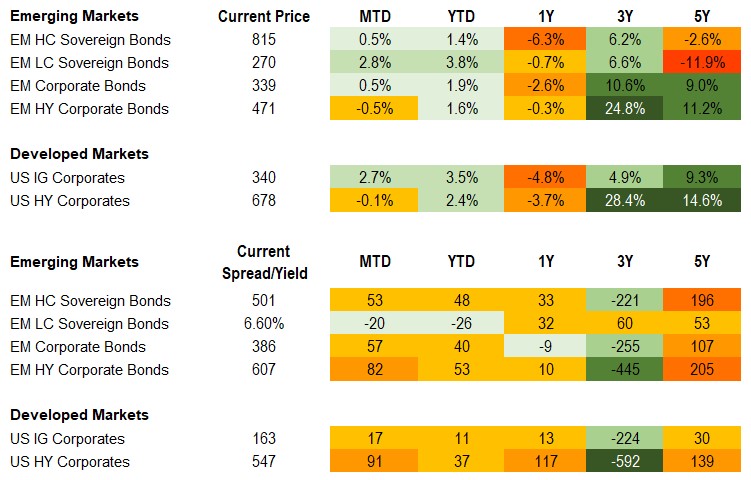
Equities
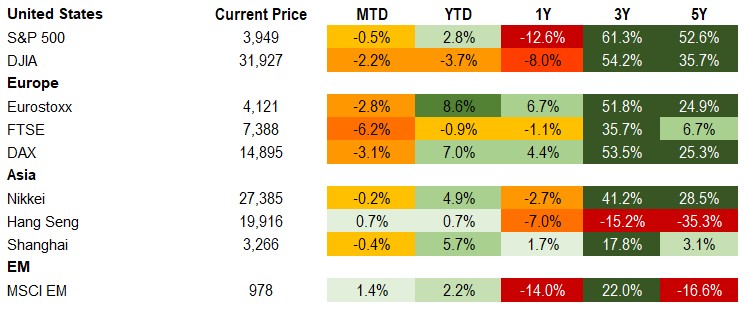
Commodities

Source for data tables: Bloomberg, JPMorgan, Gramercy. EM Fixed Income is represented by the following JPMorgan Indicies: EMBI Global, GBI-EM Global Diversified, CEMBI Broad Diversified and CEMBI Broad High Yield. DM Fixed Income is represented by the JPMorgan JULI Total Return Index and Domestic High Yield Index. Fixed Income, Equity and Commodity data is as of March 24, 2023 (mid-afternoon).
Emerging Markets Weekly Highlights
IMF approves 4-year $3bn program for Sri Lanka
Event: Having reached a Staff Level Agreement (SLA) with the Sri Lankan Government on a program back in September 2022, the IMF formalized the Agreement this week when its Executive Board approved a 48-month Extended Fund Facility (EFF) arrangement for around $3 bn, $333mm of which will be available for immediate disbursement.
Gramercy commentary: The IMF’s final stamp of approval on a program is a big step toward resolving Sri Lanka’s series of economic, political and social crises. The $3bn of forthcoming IMF funding will go a long way to alleviate the economy’s external capital needs and will likely catalyze fresh financing support from other multilateral and development partners. Importantly, it is also a credit-positive development and opens the door to making tangible progress in the sovereign’s negotiations with private creditors over a debt restructuring. This could be a prelude to Sri Lanka’s return to global capital markets in the near future, provided the debt restructuring concludes without major delays and the IMF program remains on track in the coming years. The IMF has called for close and timely collaboration between Sri Lanka and all its creditors in order to achieve a debt treatment that will restore debt sustainability consistent with the program’s parameters and equitable burden sharing among creditors. As a reminder, in order to receive Board approval, the government was required by the IMF to obtain specific and credible assurances from its major official bilateral creditors (i.e., Paris Club, China, India) that debt relief measures consistent with the IMF program assumptions will be provided. The next step would be to complete negotiations with private creditors on around $15bn of Eurobonds outstanding. Against the backdrop of the latest developments, we expect ultimate recovery values to provide a decent upside relative to current trading levels for the sovereign bond complex; we see scope for potential further enhancement in the form of GDP warrants that could provide additional upside in the event Sri Lanka’s economy recovers faster than expected over the medium-term.
Argentina evolved tactics to manage challenged macroeconomic backdrop
Event: Argentina’s Minister of Economy, Sergio Massa, announced new decrees in which public agencies will have to exchange their holdings of NY law USD sovereign bonds (~$4bn) for ARS bonds and then be delisted as well as sell their holdings of local law USD sovereign bonds (~$7bn) in the market. Over two-thirds of the proceeds are to be used to participate in future tenders of the Treasury and the remaining to finance budget expenditure. This also allows the government to circumvent the IMF requirement to avoid use of FX reserves to intervene in the FX market.
Gramercy commentary: The development is on brand for this administration which has taken a mixed approach in terms of managing macroeconomic fragilities and wants to avoid a devaluation ahead of the election. While this will likely be moderately effective in the short-term, it risks exacerbating ongoing challenges and imbalances and is an uncomfortable action in spite of the IMF’s guidance. Nevertheless, we anticipate the authorities will continue to deploy similar tactics to muddle through between now and the election. The diminishing return of such measures, particularly amid the ongoing drought and increasingly challenged economic backdrop, is likely to keep asset volatility elevated. If this administration is eventually forced to adjust the official FX rate and it is done orderly, we think investors would view it constructively. Meanwhile, 4Q22 real GDP data showed a 1.5% contraction in sequential terms while recent monthly activity indicators have also moved comfortably into negative territory, reinforcing the country’s familiarity with the unfortunate combination of negative growth and high inflation, and driving demand for policy change.
Emerging Markets Technicals

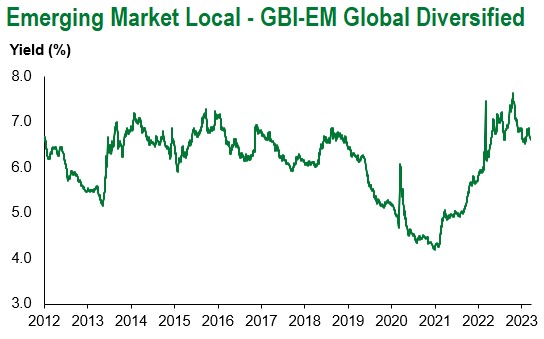
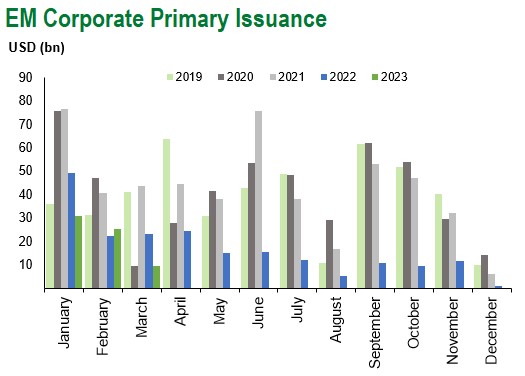
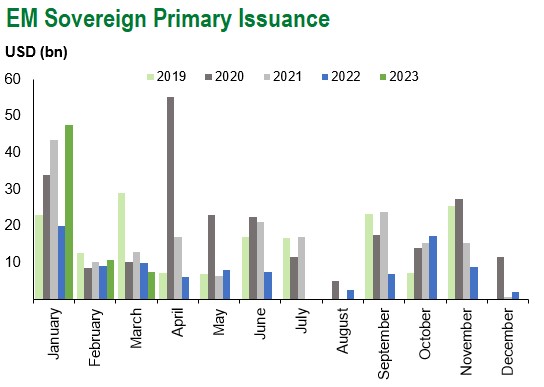
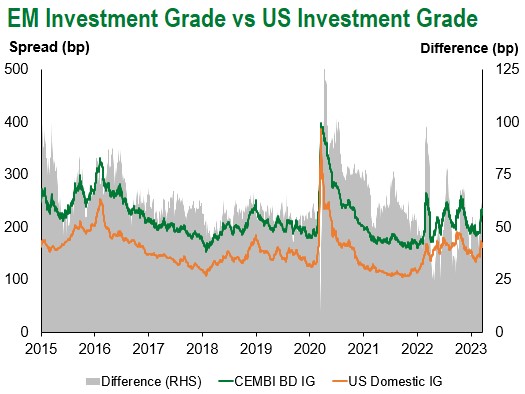
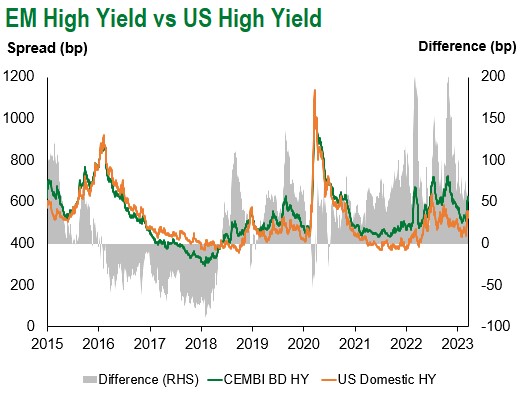
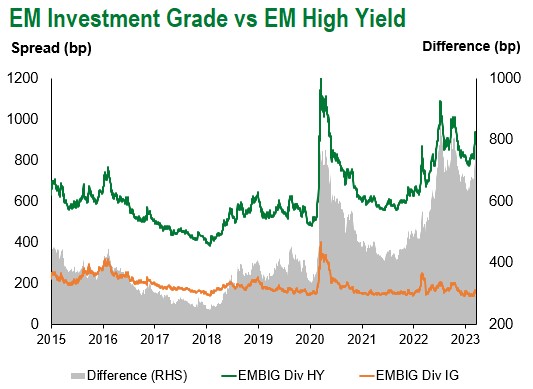
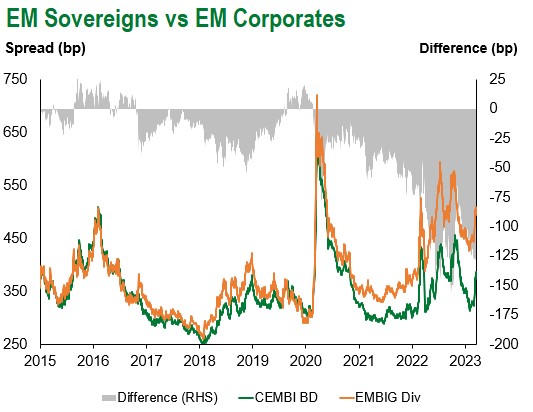
Emerging Markets Flows
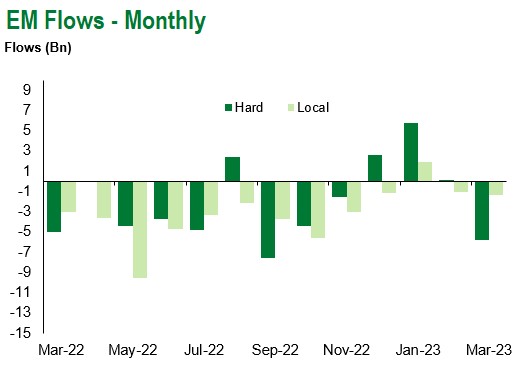
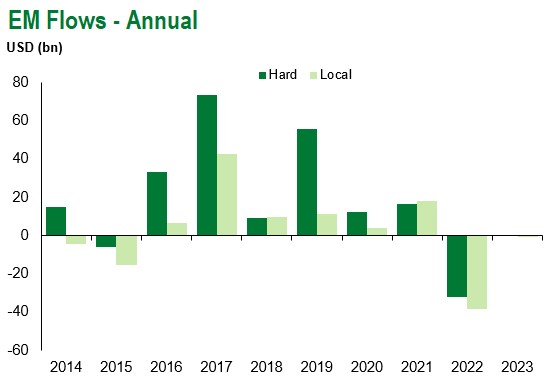
Source for graphs: Bloomberg, JPMorgan, Gramercy. As of March 24, 2023.
For questions, please contact:
Kathryn Exum, CFA ESG, Director, Co-Head of Sovereign Research, [email protected]
Petar Atanasov, Director, Co-Head of Sovereign Research, [email protected]
James Barry, Director, Deputy Portfolio Manager, [email protected]
This document is for informational purposes only. The information presented is not intended to be relied upon as a forecast, research or investment advice, and is not a recommendation, offer or solicitation to buy or sell any securities or to adopt any investment strategy. Gramercy may have current investment positions in the securities or sovereigns mentioned above. The information and opinions contained in this paper are as of the date of initial publication, derived from proprietary and nonproprietary sources deemed by Gramercy to be reliable, are not necessarily all-inclusive and are not guaranteed as to accuracy. This paper may contain “forward-looking” information that is not purely historical in nature. Such information may include, among other things, projections and forecasts. There is no guarantee that any forecasts made will come to pass. Reliance upon information in this paper is at the sole discretion of the reader. You should not rely on this presentation as the basis upon which to make an investment decision. Investment involves risk. There can be no assurance that investment objectives will be achieved. Investors must be prepared to bear the risk of a total loss of their investment. These risks are often heightened for investments in emerging/developing markets or smaller capital markets. International investing involves risks, including risks related to foreign currency, limited liquidity, less government regulation, and the possibility of substantial volatility due to adverse political, economic or other developments. References to any indices are for informational and general comparative purposes only. The performance data of various indices mentioned in this update are updated and released on a periodic basis before finalization. The performance data of various indices presented herein was current as of the date of the presentation. Please refer to data returns of the separate indices if you desire additional or updated information. Indices are unmanaged, and their performance results do not reflect the impact of fees, expenses, or taxes that may be incurred through an investment with Gramercy. Returns for indices assume dividend reinvestment. An investment cannot be made directly in an index. Accordingly, comparing results shown to those of such indices may be of limited use. The information provided herein is neither tax nor legal advice. Investors should speak to their tax professional for specific information regarding their tax situation.
